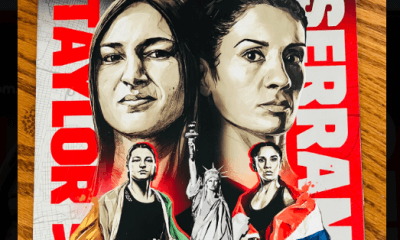Featured Articles
A Conversation About Boxing with Author and Journalist Steve Marantz

If you ask former sportswriter Steve Marantz when was boxing’s Golden Age, he’s quick with a response.
His answer just so happens to coincide with the period when he was on the beat as a boxing columnist for the Boston Globe (1979-1987).
“You could argue that boxing has had a few Golden Ages, but yes, that was an exciting and memorable era,” said Marantz, who sat ringside for many legendary matches. “The round-robin bouts amongst [Ray] Leonard, [Marvin] Hagler, [Thomas] Hearns and [Roberto] Duran, certainly was a major element.”
Those four legends are important but other weight division kings also played an integral role in boxing’s global popularity.
“Let’s not forget [Aaron] Pryor, [Alexis] Arguello, [Julio Cesar] Chavez, [Salvador] Sanchez, [Hector] Camacho, [Wilfredo] Gomez, Michael Spinks, [Dwight Muhammad] Qawi, [Donald] Curry, [Mike] Tyson and [Evander] Holyfield,” Marantz offered. “The key was competitive balance in most of the divisions.”
Marantz began his journalism career in 1973 at the Kansas City Star after graduating from the University of Missouri. After leaving the Globe, he worked for the Boston Herald (1999-2004) and ESPN (2004-2016). Nowadays, in addition to freelance writing for publications such as the Jewish Journal of Greater Boston, he produces the podcast “Championship Stories.”
Marantz recalled one particular moment that stood out while covering boxing and it happened at Aaron Pryor’s training camp.
“I have a vivid memory of his workout before he fought Arguello in Miami, November 1982. He had a hot funk song on the speakers, “You Dropped A Bomb On Me,” and as it played, loudly, he shadow-boxed to its beat and lyrics,” he recalled. “A rope was stretched across the gym, four feet off the floor, and Pryor moved along the rope, ducking under and back, gloves flashing. He was hypnotized by the music, in a trance. Hypnotized me, too. A moment that made boxing so cool to cover.”
That classic matchup at the famed Orange Bowl was halted in the 14th round with Pryor winning by technical knockout.
Anyone at Caesars Palace on April 15, 1985, knows what happened over roughly eight minutes of hot action when Hagler and Hearns tangled. It was nonstop punches from both participants.
“Hagler and Hearns fought as if possessed,” recalled Marantz of that showdown. “The stark final image [for me] was that of Hearns, now helpless, semiconscious, looking very like a black Christ taken from the cross, in the arms of a solemn aide.
“Hagler’s pent-up bitterness found release in a violent attack, even as each crack of Hearns’ gloves reinforced a lifetime of slights. In the end, Hearns was martyred to absolve Hagler of victimization. The first round is legendary, among the most vicious and splendid ever fought on the big fight stage. Action accelerated so quickly that spectators were left breathless. Punches windmilled into a blur, though the actual count was 82 punches for Hagler and 83 for Hearns, about three times that of a typical round.”
While that fight has blended into boxing folklore, a 1976 Olympic gold medal winner from Palmer Park, Maryland, was the epitome of true greatness for Steve Marantz.
“The way Sugar Ray Leonard maneuvered [Roberto] Duran to ‘No Mas’ in their rematch was brilliant. His grit and toughness beat Hearns, one of the great fights of the 1980s. And he beat Hagler with brains and psychology. Not to overlook his win over [Wilfred] Benitez in 1979. He was gorgeous to watch, stylish and rhythmic. His combinations were a blur. And he strategized like a chess master. Smooth and cooperative in interviews, always aware of the marketing and promotional necessities. Leonard was the gold standard.”
Marantz re-visited the Hagler-Leonard fight and the drama that surrounded it in “Sorcery at Caesars: Sugar Ray’s Marvelous Fight,” first released in 2008 and now available as an eBook.
Boxing’s been called the cruelest and the most unforgiving sport, but it’s also filled with high drama.
“It’s a test of athleticism, intelligence, grit and character. At its best, it’s dramatic and unpredictable, exciting,” Marantz said of the fight game. “A rich history of iconic personalities and events. Joe Louis and Max Schmeling, for example. A window into history bigger than just sport, a window into popular culture and politics.”
Marantz fondly recalls some of the characters he met while covering the sweet science: “Promoters Don King and Bob Arum, both conniving quotable snakes. Trainer Ray Arcel, in his 80s, a pillar of honesty and integrity. Emanuel Steward and Prentiss Byrd, running the Kronk Gym as a beacon of light and hope in Detroit’s blighted inner city. In Brockton, Massachusetts, two Italian-American brothers, Goody and Pat Petronelli, formed a sacred trust with an African- American boxer, Marvin Hagler.”
Marantz went on: “On my first newspaper job with the Kansas City Times/Star, I met a kindly trainer, Peyton Sher, who welcomed me into his gym and taught me the basics,” he said. “Never will forget Daeshik Seo, the Korean therapist for Larry Holmes who two weeks before the Holmes-[Gerry] Cooney fight in June 1982, tipped me to a story that a member of Holmes’ entourage pulled a pistol on Cooney’s entourage at Caesars Palace. Caesars top brass had to call Holmes on the carpet to get his people under control. Holmes was incensed at the story. In his media session after he won, he said I wrote it because I was [expletive] … and that I worked in a racist city, Boston.”
Marantz has never been put off by the seedy elements of the sport. “I don’t feel polarized by it.,” he says. “Nobody is forced to box. Nobody is forced to watch it. The world has bigger problems than boxing.”
Marantz has fond memories of the people he met and the friendships he made while covering boxing. Does he miss not being rinigside? “Not really,” he says. “My time came and went. Journalism and life took me in other directions. I do have some nostalgia for that era, and for the people who were part of it.”
Having been around the sweet science for a spell, Marantz offered sage advice to anyone inclined to mix it up: “Be disciplined, work hard, find a good trainer, learn the subtleties, read the tea leaves and don’t be pig-headed.”
Actually, all of those traits are always handy, even if one doesn’t step into the ring.
You can read more about Steve Marantz at his website: www.stevemarantz.com
To comment on this story in the Fight Forum CLICK HERE
-

 Featured Articles4 weeks ago
Featured Articles4 weeks agoAvila Perspective, Chap. 330: Matchroom in New York plus the Latest on Canelo-Crawford
-

 Featured Articles3 weeks ago
Featured Articles3 weeks agoVito Mielnicki Jr Whitewashes Kamil Gardzielik Before the Home Folks in Newark
-

 Featured Articles21 hours ago
Featured Articles21 hours agoResults and Recaps from New York Where Taylor Edged Serrano Once Again
-

 Featured Articles4 weeks ago
Featured Articles4 weeks agoCatching Up with Clay Moyle Who Talks About His Massive Collection of Boxing Books
-

 Featured Articles5 days ago
Featured Articles5 days agoFrom a Sympathetic Figure to a Pariah: The Travails of Julio Cesar Chavez Jr
-

 Featured Articles3 weeks ago
Featured Articles3 weeks agoMore Medals for Hawaii’s Patricio Family at the USA Boxing Summer Festival
-

 Featured Articles1 week ago
Featured Articles1 week agoCatterall vs Eubank Ends Prematurely; Catterall Wins a Technical Decision
-

 Featured Articles4 weeks ago
Featured Articles4 weeks agoRichardson Hitchins Batters and Stops George Kambosos at Madison Square Garden




















